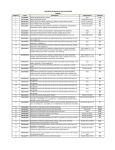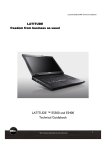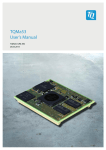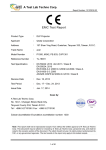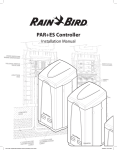Download Dell Inspiron 1427 Setup guide
Transcript
INSPIRON™ 1427 SETUP GUIDE INSPIRON™ 1427 SETUP GUIDE Notes, Notices, and Cautions NOTE: A NOTE indicates important information that helps you make better use of your computer. NOTICE: A NOTICE indicates either potential damage to hardware or loss of data and tells you how to avoid the problem. CAUTION: A CAUTION indicates a potential for property damage, personal injury, or death. _________________ Information in this document is subject to change without notice. © 2008 Dell Inc. All rights reserved. Reproduction of these materials in any manner whatsoever without the written permission of Dell Inc. is strictly forbidden. Trademarks used in this text: Dell, the DELL logo, Insprion, YOURS IS HERE and Dell Inc. Intel and Core 2 Duo are registered trademarks of Intel Corporation, Microsoft, Windows and Windows Vista are trademarks or registered trademarks of Microsoft Corporation in the United States and/or other countries/regions. Bluetooth is a registered trademark owned by Bluetooth SIG, Inc. and is used by Dell Inc. under license. Other trademarks and trade names may be used in this document to refer to either the entities claiming the marks and names or their products.Dell Inc. disclaims any proprietary interest in trademarks and trade names other than its own. January 2009 P/N F243R Rev. A00 Setting Up Your Inspiron Laptop ........... 5 Before Setting Up Your Computer ................5 Connect the AC Adapter ................................6 Connect the Network Cable (optional) ..........7 Press the Power Button ................................8 Windows Vista Setup ....................................9 Connect to the Internet (optional) ................9 Network Problems ...................................... 22 Power Problems ......................................... 23 Memory Problems ...................................... 24 Lockups and Software Problems ................ 24 Dell Diagnostics ......................................... 27 Restore the Operating System..............28 Using Your Inspiron Laptop .................... 12 Right side View ..........................................12 Left side View ..............................................14 Front view ...................................................16 Back View ...................................................18 Removing and Replacing the Battery ..........19 Software Features ........................................20 Troubleshooting................................... 22 3 INSPIRON Contents Getting Help ......................................... 33 Technical Support and Customer Service ....34 Online Services ...........................................34 Product Information ....................................35 Before You Call ............................................36 Contacting Dell ............................................37 Finding More Information and Resources.. 38 Specifications ...................................... 40 Index.................................................... 48 4 INSPIRON Setting Up Your Inspiron Laptop This section provides information about setting up your Inspiron 1427 laptop and connecting peripherals. Before Setting Up Your Computer When positioning your computer, ensure that you allow easy access to a power source, adequate ventilation, and a level surface to place your computer. Restricting airflow around your Inspiron laptop may cause it to overheat. To prevent overheating, ensure that you leave at least 10.2cm (4in. ) at the back of the computer and a minimum of 5.1cm (2in. ) on all other sides. When the computer is powered on, you should never put it in an enclosed space, such as a cabinet or drawer. NOTICE: Placing or stacking heavy or sharp objects on the computer may result in permanent damage to the computer. 5 Setting Up Your Inspiron Laptop Connect the AC Adapter Connect the AC adapter to the computer and then plug it into a wall outlet or surge protector. 6 CAUTION:The AC adapter works with electrical outlets worldwide. However, power connectors and power strips vary among countries. Using an incompatible cable or improperly connecting the cable to a power strip or electrical outlet may cause fire or equipment damage. Setting Up Your Inspiron Laptop Connect the Network Cable (Optional) To establish a wired network connection, plug in the network cable. 7 Setting Up Your Inspiron Laptop Press the Power Button 8 Setting Up Your Inspiron Laptop Windows Vista Setup If you ordered Windows Vista operating system with your computer, it is already configured. To set up Windows Vista for the first time, follow the instructions on the screen. These steps are mandatory and may take up to 15 minutes to complete. The screens will take you through several procedures, including accepting license agreements, setting preferences and configuring an Internet connection. NOTICE: Do not interrupt the operating system’s setup process. Doing so may render your computer unusable. Connect to the Internet (Optional) NOTE: If you cannot connect to the Internet but have successfully connected in the past, the ISP might be having a service outage. Contact your ISP to check the service status, or try connecting again later. NOTE: Have your ISP information ready. If you do not have an ISP, Connect to the Internet wizard can help you get one. Setting Up a Wired Internet Connection in Windows Vista If you are using a DSL or cable/satellite modem connection, contact your ISP or cellular telephone service for setup instructions and see “Setting Up Your Internet Connection in Windows Vista” on page 11. NOTE: ISPs (Internet Service Providers) and ISP offerings vary by country and region. To connect to the Internet, you need an external modem or network connection and an Internet service provider (ISP). 9 Setting Up Your Inspiron Laptop Setting Up a Wireless Internet Connection in Windows Vista Wireless Router Internet Service Portable Computer with Wireless Internet Card Cable Modem or DSL Modem 1. Internet Service 2. Cable Modem or DSL Modem 3. Wireless Router 4. Portable Computer with Wireless Internet Card 10 For more information on setting up and using wireless see the user manual of the computer or router. Before you can use your wireless Internet connection, you need to connect to your wireless router. To set up a wireless router connection: 1. Save and close any open files, and exit any open programs. 2. Click Start → Connect To. 3. Follow the instructions on the screen to complete the setup. Setting Up Your Inspiron Laptop Setting Up Your Internet Connection in Windows Vista To set up an Internet connection, perform the steps in the following section. 1. Save and close any open files, and exit any open programs. 2. Double-click the ISP icon on the desktop. 3. Follow the instructions on the screen to complete the Microsoft Windows setup. If there is no ISP icon on the desktop or you wish to use a different ISP for your Internet connection, perform the steps in the following section. NOTE: If you cannot connect to the Internet but have successfully connected in the past, the ISP might be having a service outage. Contact your ISP to check the service status, or try connecting again later. NOTE: Have your ISP information ready. If you do not have an ISP, Connect to the Internet wizard can help you get one. 1. Save and close any open files, and exit any open programs. 2. Click Start → Control Panel. 3. Under Network and Internet, click on the Connect to the Internet link. Connect to the Internet wizard will be displayed. 4. Select your preferred connection type by clicking on Broadband (PPPoE) or Dial-up: a. If you are using a DSL, satellite or cable modem, or Bluetooth wireless technology, select Broadband. b. If you are using an external USB modem or ISDN, select Dial-up. NOTE: If you do not know which type of connection to select, click Help me choose or contact your ISP. 5. Follow the instructions on the screen and use the information provided by your ISP to complete the setup. 11 INSPIRON Using Your Inspiron Laptop Your Inspiron 1427 has indicators, buttons, and features that provide information at-a-glance and time-saving shortcuts for common tasks. Right Side View 1 12 2 3 Using Your Inspiron Laptop 1. Optical drive: You can input/output data for different purposes, such as burning CDs or playing DVDs. 2. USB connectors: Connect to USB devices, such as a mouse, keyboard, printer, external device, or an MP3 player. 3. AC adapter connector: Connects to the AC adapter to power on the computer and charge the battery when the computer is not in use. 13 Using Your Inspiron Laptop Left Side View 1 14 2 3 4 5 6 7 8 Using Your Inspiron Laptop 1. VGA connector: Connects to a monitor or projector. 2. Network connector (RJ-45): Connects the computer to a Local Area Network (LAN). 3. High Power USB connectors: Connects to high power devices that draw more than 100mA from the USB power line, such as digital cameras and external hard drives. 8. Headphone connector: Attach headphones or stereo speakers to this connector. The internal speakers are used when you attach headphones or stereo speakers to this port. 4. 1394 IEEE 1394 connector: Connects devices supporting IEEE 1394 high-speed transfer rates, such as some digital video cameras. 5. PCI-Express Card slot: Supports 54mm PCIExpress Cards. 6. 3-in-1 memory cardreader: Supports SD/MMC/ MS memory cards, commonly used for digital still cameras and portable digital devices. 7. Microphone connector: Attach a microphone to this connector. 15 Using Your Inspiron Laptop Front view 1 2 3 3 4 5 6 6 7 8 9 11 10 16 Using Your Inspiron Laptop 1. LCD latch: Secures the LCD display panel to the notebook. When opening the notebook, push the LCD latch to the right and lift the display panel. When you close the notebook, the LCD latch will hold the display panel in place. 2. Built-in camera: The webcam is equipped with a 2. 0 megapixel CMOS sensor. 3. Built-in microphone: Provides audio input without connecting an external device. 4. LCD display: Your computer comes with a 14. 1" COLOR TFT/WXGA LCD display. 5. Power button: Press to power on your computer. 6. Speakers: Provide audio output. 7. Keyboard: Includes a numeric keypad and the Microsoft Windows logo key 10.Wireless switch: Turn the wireless connection on or off. When the wireless connection is turned on, the wireless status light on the front of the computer lights up. 11.Status/Power light Power (blue) Battery charging (blue/amber) Wireless connection (blue)/Bluetooth (amber) Flashing power light indicates the computer is in standby mode. . 8. Touch pad: Provides the functionality of a mouse. 9. Touch pad buttons: Use these buttons much like the left and right buttons of a mouse when you use the touch pad to move the cursor on the display. 17 Using Your Inspiron Laptop Back view Kensington Lock Kensington lock: You can attach a commercially available anti-theft device to the computer. NOTE: Before you buy an anti-theft device, make sure that it works with the Kensington lock on your computer. 18 Using Your Inspiron Laptop Removing and Replacing the Battery CAUTION: Using an incompatible battery may increase the risk of fire or explosion. CAUTION: Do not dispose of the battery with household waste. For more information about recycling the battery, contact your local recycling center. To remove the battery: 1. Slide the battery lock switch to the right into the unlocked position. 2. Slide the battery release latch to the left, and gently slide the battery out of the battery bay. To replace the battery, slide the battery into the battery bay and slide the battery lock switch to the left into the locked position. 1. Battery 2. Battery release latch 3. Battery lock switch 19 Using Your Inspiron Laptop Software Features NOTE: For more details on the contents in this section, see the hard drive or Dell Technology Guide at Dell Support, support. dell. com. Productivity and Communication You can use your computer to create presentations, brochures, greeting cards, flyers, and spreadsheets depending on the applications installed in your computer. Check your purchase order for software installed on your computer. Once connected to the Internet, you can access websites, setup an e-mail account, upload and download files and more. Entertainment and Multimedia You can use your computer to watch videos, play games and listen to music and to internet radio stations. 20 Customizing the Desktop in Windows Vista You can use the Personalize appearance and sounds window to customize your desktop and change the appearance, resolution, wallpaper, screensaver and more. To access the display properties window: 1. Right-click an open area of the desktop. 2. Click Personalize to open the Personalize appearance and sounds window and learn more about your customization options. Using Your Inspiron Laptop Personalize power settings You can use the power management options in the Windows operating system to personalize power settings for your computer. Microsoft® Windows Vista® provides three default settings: • Balanced — Offers full performance when you need it and saves power during periods of inactivity. • Power saver — Saves power by reducing system performance for maximum operating time. • High performance — Maximizes system performance and responsiveness based on your past activities. Backing Up Data It is recommended that you regularly back up data and folders stored on your computer. To back up your data: 1. Click Start → Control Panel → System and Maintenance → Welcome Center → Transfer files and settings. 2. Click Back up files or Back up computer. 3. Click User Account Control, then click Continue, and follow the instructions of the Back up Files wizard. The following section provides information for solving any problems you may encounter while using your computer. If the problem cannot be resolved, see "Contacting Dell" on page 37. 21 INSPIRON Troubleshooting Network Problems Wireless Connections If the wireless network connection is lost — You can manage the Wireless LAN using Windows Wireless Network Connections, accessed from the Control Panel. — Interference may be blocking or interrupting your wireless connection. Try moving the computer closer to your wireless router. Wired Connections If the network connection is lost — The cable is loose or damaged. • Check the cable to ensure it is plugged in and not damaged. 22 The link integrity light on the integrated network connector lets you verify that your connection is working and provides information on the status: • Green — A good connection exists between a 10-Mbps network and the computer. • Orange — A good connection exists between a 100/1000-Mbps network and thecomputer. • Off — The computer cannot detect a physical connection to the network. NOTE: The link integrity light on the network connector is only for the wired cable connection. The link integrity light does not indicate wireless connection status. NOTE: If you cannot connect to the Internet but have successfully connected in the past, the ISP might have a service outage. Contact your ISP to check the service status, or try connecting again later. Troubleshooting Power Problems If the power light is off — The computer is either turned off or is not receiving power. • Reseat the power cable into both the power connector on the computer and the electrical outlet. • Ensure that the electrical outlet is working by testing it with another device, such as a lamp. • Check the AC adapter cable connections. If the AC adapter has a light, ensure that the light on the AC adapter is on. If the power light is solid blue and the computer is not responding — The display may not be responding. Press the power button until the computer turns off and then turn it back on. If the power light is flashing blue — The computer is in standby mode. Press a key on your keyboard, move the pointer using the touch pad or a connected mouse, or press the power button to resume normal operation. If you encounter interference that hinders reception on your computer — An unwanted signal is creating interference by interrupting or blocking other signals. Some possible causes of interference are: • Power, keyboard, and mouse extension cables. • Too many devices connected to a power strip. 23 Troubleshooting Memory Problems If you experience other memory problems — If you receive an insufficient memory message — • Check if the memory module is compatible with your computer. Your computer supports DDR2 memory. For more information about the type of memory supported by your computer, see the “Specifications” on page 40. • Save and close any open files and exit any open programs you are not using to see if that resolves the problem. • See the software documentation for minimum memory requirements. • Run the Dell Diagnostics (see the “Dell Diagnostics” on page 27). Lockups and Software Problems If the computer does not start up — Ensure that the power cable is firmly connected to the computer and to the electrical outlet. 24 Troubleshooting If a program stops responding — End the program: 1. Press <Ctrl><Shift><Esc> simultaneously. 2. Click Applications. 3. Click the program that is no longer responding. 4. Click End Task. If a program crashes repeatedly — Check the software documentation. If necessary, uninstall and then reinstall the program. NOTE: Software usually includes installation instructions in its documentation or on the media (CD or DVD). If a program is designed for an earlier Microsoft® Windows® operating system — Run the Program Compatibility Wizard. The Program Compatibility Wizard configures a program so that it runs in an environment similar to non-Windows Vista operating system environments. 1. Click Start → Control Panel → Programs → Use an older program with this version of Windows. 2. In the welcome screen, click Next. 3. Follow the instructions on the screen. If the computer stops responding — NOTICE: You might lose data if you are unable to perform an operating system shutdown. Turn off the computer. If you are unable to get a response by pressing a key on your keyboard or moving your pointer using the touch pad or mouse, press and hold the power button for at least 8 to 10 seconds until the computer turns off and then restart your computer. 25 Troubleshooting If a solid blue screen appears — Turn the computer off. If you are unable to get a response by pressing a key on your keyboard or moving your pointer using the touch pad or mouse, press and hold the power button for at least 8 to 10 seconds until the computer turns off and then restart your computer. If you have other software problems — • Back up your files immediately. • Use a virus-scanning program to check the hard drive or CDs. • and close any open files or programs and shut down your computer through the “Start” menu. • Check the software documentation or contact the software manufacturer for troubleshooting information: – Ensure that the program is compatible with the operating system installed on your computer. 26 – Ensure that your computer meets the minimum hardware requirements needed to run the software. See the software documentation for information. – Ensure that the program is installed and configured properly. – Verify that the device drivers do not conflict with the program. – If necessary, uninstall and then reinstall the program. – Write down any error message that is displayed to help in troubleshooting. Troubleshooting Dell Diagnostics If you experience a problem with your computer, perform the checks in “Lockups and Software Problems” on page 24 and run the Dell Diagnostics before you contact Dell for technical assistance. It is recommended that you print these procedures before you begin. NOTICE: Dell Diagnostics works only on Dell computers. NOTE: The Drivers and Utilities media is optional and may not ship with your computer. See the System Setup section in the “Service Manual” to review your computer’s configuration information, and to ensure that the device you want to test displays in the system setup program and is active. Start the Dell Diagnostics from your hard drive or from the Drivers and Utilities media. Starting Dell Diagnostics From Your Hard Drive The Dell Diagnostics is located on a hidden diagnostic utility partition on your hard drive. NOTE: If your computer cannot display a screen image, see the “Contacting Dell” on page 37. 1. Ensure that the computer is connected to an electrical outlet that is known to be working properly. 2. Turn on (or restart) your computer. 3. When the DELLTM logo appears, press <F12> immediately. Select Diagnostics from the boot menu and press <Enter>. NOTE: If you wait too long and the operating system logo appears, continue to wait until you see the Microsoft® Windows® desktop; then, shut down your computer and try again. 4. Press any key to start the Dell Diagnostics from the diagnostics utility partition on your hard drive. 27 INSPIRON Restoring Your Operating System You can restore your operating system in the following ways: • System Restore can restore your computer to an earlier state without affecting data files. Use System Restore as the first solution for restoring your operating system and preserving data files. • Dell Factory Image Restore returns your hard drive to the original state from when it was shipped to you. All data on your hard drive will be permanently deleted, including any programs you have installed. Use Dell Factory Image Restore only when System Restore does not resolve your operating system problem. • If you received an Operating System disc with your computer, you can use it to restore your operating system. However, using the Operating System disc also deletes all data on the hard drive. Use the disc only when System Restore does not resolve your operating system problem. 28 System Restore The Windows operating system provides a System Restore option. If system changes such as hardware and software updates cause your computer to become unstable, you can use System Restore to restore it to an earlier state (without affecting data files). You can undo the last system restore. NOTICE: Regularly back up your data files. System Restore does not monitor your data files or recover them. NOTE: The instructions in this document are written for Windows default view and do not apply if you have set your DellTM computer to the Windows Classic View. Restoring Your Operating System Starting System Restore 1. Click Start. 2. In the Start Search box, type System Restore and press <Enter>. NOTE: The User Account Control window might appear. If you are an administrator on the computer, click Continue; otherwise, contact your administrator to continue. 3. Click Next and follow the remaining prompts on the screen. If System Restore does not resolve your problem, you can undo the last system restore. Undoing the Last System Restore NOTE: Before you undo the last system restore, save and close any open files, and exit any open programs. Do not alter, open, or delete any documents or programs until system restoration is complete. 1. Click Start. 2. In the Start Search box, type System Restore and press <Enter>. 3. Click Undo my last restoration and click Next. 29 Restoring Your Operating System Dell Factory Image Restore NOTICE: Dell Factory Image Restore permanently deletes all data on your hard drive, including any programs or drivers you have installed. If possible, back up your data before using Dell Factory Image Restore. Use Dell Factory Image Restore only when System Restore does not resolve your operating system problem. NOTE: Dell Factory Image Restore may not be available in certain countries or on certain computers. Use Dell Factory Image Restore only as the last method to restore your operating system. This option restores your hard drive to the operating state it was in when you purchased the computer. Any programs or files added since you received your computer (including data files) are permanently deleted from the hard drive. Data files include documents, spreadsheets, e-mail messages, digital photos, music files, and so on. If possible, back up all data before using Factory Image Restore. 30 Dell Factory Image Restore 1. Turn on the computer. When the Dell logo appears, press <F8> several times to access the Vista Advanced Boot Options window. 2. Select Repair Your Computer. 3. The System Recovery Options window appears. 4. Select a keyboard layout and click Next. 5. To access the recovery options, log on as a local user. To access the command prompt, type administrator in the User name field, then click OK. 6. Click Dell Factory Image Restore. The Dell Factory Image Restore welcome screen appears. NOTE: *Make sure to plug in the adapter first before running the Dell Factory Image Restore. Please be patient until the restore process is completely finished. *Please make sure to turn on the Wireless switch when restoring your computer. 7. Click Next. The Confirm Data Deletion screen appears. Restoring Your Operating System NOTICE: If you do not want to proceed with Factory Image Restore, click Cancel. 8. Click the check box to confirm that you want to continue reformatting the C drive and restoring the system software to the factory condition, and then click Next. The restore process begins and may take five or more minutes to complete. A message appears when the operating system and factory-installed applications have been restored to factory condition. 9. Click Finish to reboot the system. NOTE: Please wait until the process is finished and the screen below appears. Reinstalling the Operating System Before you Begin If you are considering reinstalling the Windows operating system to correct a problem with a newly installed driver, first try using Windows Device Driver Rollback. If Device Driver Rollback does not resolve the problem, then use System Restore to return your operating system to the operating state it was in before you installed the new device driver. See "System Restore" on page 28. NOTICE: Before performing the installation, back up all data files on your primary hard drive. For conventional hard drive configurations, the primary hard drive is the first drive detected by the computer. To reinstall Windows, you need the following items: • Dell Operating System media • Dell Drivers and Utilities media 31 Restoring Your Operating System NOTE: The Dell Drivers and Utilities media contains drivers that were installed during the assembly of the computer. Use the Dell Drivers and Utilities media to load any required drivers. Depending on the region from which you ordered your computer, or whether you requested the media, the Dell Drivers and Utilities media and Operating System media may not ship with your computer. Reinstalling Windows Vista The reinstallation process can take one to two hours to complete. After you reinstall the operating system, you must also reinstall the device drivers, virus protection program, and other software. 1. Save and close any open files, and exit any open programs. 2. Insert the Operating System disc. 3. Click Exit if the Install Windows message appears. 4. Restart the computer. 5. When the DELL™ logo appears, press <F12> immediately. 32 NOTE: If you wait too long and the operating system logo appears, continue to wait until you see the Microsoft® Windows® desktop; then, shut down your computer and try again. NOTE: The next steps change the boot sequence for one time only. On the next start-up, the computer boots according to the devices specified in the system setup program. 6. When the boot device list appears, highlight CD/ DVD/CD-RW Drive and press <Enter>. 7. Press any key to Boot from CD-ROM. Follow the instructions on the screen to complete the installation. If you experience a problem with your computer, you can complete the following steps to diagnose and troubleshoot the problem: 1. See “Troubleshooting” on page 22 for information and procedures that pertain to the problem your computer is experiencing. 2. See “Dell Diagnostics” on page 27 for procedures on how to run Dell Diagnostics. 3. Fill out the “Diagnostic Checklist” on page 36. 4. Use Dell’s extensive suite of online services available at Dell Support support. dell. com for help with installation and troubleshooting procedures. See “Online Services” on page 34 for a more extensive list of Dell Support online. 5. If the preceding steps have not resolved the problem, see “Before You Call” on page 36 and then “Contacting Dell” on page 37. NOTE: Call Dell Support from a telephone near or at the computer so that the support staff can assist you with any necessary procedures. NOTE: Dell’s Express Service Code system may not be available in all countries. When prompted by Dell’s automated telephone system, enter your Express Service Code to route the call directly to the proper support personnel. If you do not have an Express Service Code, open the Dell Accessories folder, double-click the Express Service Code icon, and follow the directions. NOTE: Some of the services mentioned below are not always available in all locations outside the continental U. S. Call your local Dell representative for information on availability. 33 INSPIRON Getting Help Getting Help Technical Support and Customer Service Dell’s support service is available to answer your questions about Dell hardware. Our support staff use computer-based diagnostics to provide fast, accurate answers. To contact Dell’s support service, see “Before You Call” on page 36 and then see the contact information for your region or go to support. dell. com. Online Services You can learn about Dell products and services on the following websites: · www. dell. com · www. dell. com/ap (Asian/Pacific countries only) · www. dell. com/jp (Japan only) · www. euro. dell. com (Europe only) · www. dell. com/la (Latin American and Caribbean countries) · www. dell. ca (Canada only) 34 You can access Dell Support through the following websites and e-mail addresses: Dell Support websites · www. dell. com · support. dell. com · support. jp. dell. com (Japan only) · support. euro. dell. com (Europe only) Dell Support e-mail addresses: · mobile_support@us. dell. com · support@us. dell. com · la-techsupport@dell. com (Latin American and Caribbean countries) · apsupport@dell. com (Asian/Pacific countries only) Dell Marketing and Sales e-mail addresses: · apmarketing@dell. com (Asian/Pacific countries only) · sales_canada@dell. com (Canada only) Getting Help Anonymous file transfer protocol (FTP): · ftp. dell. com Log in as user:anonymous, and use your e-mail address as your password. Product Information If you need information about additional products available from Dell, or if you would like to place an order, visit the Dell website at www. dell. com. For the telephone number to call for your region or to speak to a sales specialist, see “Contacting Dell” on page 37. 35 Getting Help Before You Call NOTE: Have your Express Service Code ready when you call. The code helps Dell’s automated-support telephone system direct your call more efficiently. You may also be asked for your Service Tag (located on the back or bottom of your computer). Remember to fill out the following Diagnostics Checklist. If possible, turn on your computer before you call Dell for assistance and call from a telephone at or near the computer. You may be asked to type some commands at the keyboard, relay detailed information during operations, or try other troubleshooting steps possible only at the computer itself. Ensure that the computer documentation is available. 36 Diagnostic Checklist · Name: · Date: · Address: · Phone number: · Service Tag (bar code on the back or bottom of the computer): · Express Service Code: · Return Material Authorization Number (if provided by Dell support technician): · Operating system and version: · Devices: · Expansion cards: · Are you connected to a network? Yes/No · Network, version, and network adapter: · Programs and versions: Getting Help See your operating system documentation to determine the contents of the computer’s start-up files. If the computer is connected to a printer, print each file. Otherwise, record the contents of each file before calling Dell. · Error message, beep code, or diagnostic code: · Description of problem and troubleshooting procedures you performed: Contacting Dell To contact Dell for sales, technical support, or customer service issues: 1. Visit support. dell. com. 2. Verify your country or region in the Choose A Country/Region drop-down menu at the bottom of the page. 3. Click Contact Us on the left side of the page. 4. Select the appropriate service or support link based on your need. 5. Choose the method of contacting Dell that is convenient for you. NOTE: See “Before You Call” on page 36 before you contact Dell. NOTE: If you do not have an active Internet connection, you can find contact information on your purchase invoice, packing slip, bill, or Dell product catalog. Dell provides several online and telephone based support and service options. Availability varies by country and product, and some services may not be available in your area. 37 INSPIRON Finding More Information and Resources If you need to: See: reinstall your operating system your Operating System media run a diagnostic program for your computer, reinstall notebook system software, or update drivers for your computer, and read me files. the Drivers and Utilities media. upgrade your computer with new or additional memory, or a new hard drive. the “Service Manual” on the Dell Support website at support. dell. com. reinstall or replace a worn or defective part. 38 NOTE: Drivers, updates and downloads can be found on the Dell® Support website at support. dell. com. NOTE: In some countries, opening and replacing parts of your computer may void your warranty. Check your warranty and return policies before working inside your computer. Finding More Information and Resources If you need to: See: find safety/best practices information for your computer review Warranty information, Safety instructions, Regulatory information, Ergonomics information, and End User License Agreement. the safety and regulatory documents that shipped with your computer and also see the Regulatory Compliance Homepage at www. dell. com/regulatory_compliance. find your Service tag/Express Service Code — You must use the service tag to identify your computer on support. dell. com or to contact technical support. the back or bottom of your computer. find drivers and downloads. access technical support and product help. check on your order status for new purchases. find solutions and answers to common questions. locate information for last-minute updates about technical changes to your computer or advanced technical-reference material for technicians or experienced users. the DellTM Support website at support. dell. com. 39 INSPIRON Specifications System Model - Dell Inspiron 1427 This section provides basic information that you may need when setting up, updating drivers for, and upgrading your computer. NOTE: Offerings may vary by region. For more information regarding the configuration of your computer, click Start → Help and Support and select the option to view information about your computer. processor Type L2 cache External bus frequency 40 Intel® Pentium® Dual-Core Processor Intel® CoreTM 2 Duo Processor 1M, 2M, 3M 533/667/800MHz Memory Connectors Capacities Memory type Possible memory configurations two internally-accessible SO-DIMM sockets 1GB and 2GB 800 MHz DDR2 1GB, 2GB, 4GB Specifications Computer Information System Chipset Data bus width DRAM bus width Processor address bus width Flash EPROM PCI Bus Communications Intel PM45 64 bits single channel 64-bit buses 32 bits Network adapter: 10/100/1000Mbps, Broadcom 5787 MKMLG PCI-E Wireless Wireless LAN, 802. 11 b/g, 802. 11 a/b/g/n Bluetooth® wireless technology 1 MB 32 bits Video Video controller Video memory LCD interface NVIDIA GeForce® 9300M GS 512MB (GDDR2 64M16 x 4) LVDS 41 Specifications Audio Ports and Connectors Audio type 2 channel High Definition Audio controller Realtek ALC272-GR Stereo conversion 24-bit (analog-to-digital and digital-to-analog) Internal Interface Intel High Definition Audio External Interface built-in microphone microphone-in connector, stereo headphones/speakers connector Speaker two stereo speakers Internal speaker 0. 5 watt per channel into 4 ohm amplifier Volume controls program menus Audio 42 Network adapter USB Video Memory card reader PCI-Express Card slot microphone connector one stereo headphone/ speakers connector RJ-45 port four 4-pin USB 2. 0 -compliant connectors 15-hole connector one media card reader one PCI-Express Card slot, supports PCI-Express Cards Specifications Display Type (TrueLife) Size: Height Width Maximum resolution Refresh rate Operating angle Luminance Viewing Angles: 14. 1 inch WXGA 206 mm (8. 1 in. ) 320 mm (12. 5 in. ) 1280 x 800 60 Hz 0° (closed) to 135° 162 min. 180 typ. cd/m2 (5 point avg) Horizontal Vertical Pixel pitch Controls ±40° (LED) min. +15°/-30° (LED) min. 0.1905×0.189mm brightness can be controlled through keyboard shortcuts Keyboard Number of keys Supports 86/87, simulates 101/102 keys 43 Specifications Camera (optional) Pixel Video resolution Diagonal viewing angle Battery 2. 0 megapixel 320×240 ~ 1280×1024 (640×480 at 30 fps) 66° Type Depth Height Width Weight Voltage 6-cell lithium ion 58. 23mm (2. 30 in. ) 21. 5 mm (0. 8 in. ) 140. 6 mm (5. 54 in. ) 414 g (6-cell) 19 VDC 240cpi Charge time (approximate): Powered off Battery charging time varies depending on whether the computer is turned on and the number of programs that are running; 3. 5~12 hours (6-cell) Touch pad X/Y position resolution (graphics table mode) Size: Width Height 44 79. 7 mm (3. 13 in. ) sensor-active area 47. 7 mm (1. 87 in. ) rectangle Specifications Battery Operating time Life span (approximate) Temperature range: Operating Storage Coin-cell battery AC Adapter Varies depending on operating conditions and can be significantly reduced under certain power-intensive conditions. For more information, see “DellTechnology Guide”. 300 discharge/charge cycles 0° to 35° (32° to 95°F) -40° to 65°C (-40° to 149°F) CR-2032 Input voltage Input current (maximum) Input frequency Output power Output current Rated output voltage Dimensions: Height Width Depth Weight (with cables) 100–240 VAC 1. 5 A 50–60 Hz 90 W 4. 74 A (maximum at 4s pulse) 19 VDC 34. 2 mm (1. 35 in. ) 60. 9 mm (2. 39 in. ) 153. 42 mm (6. 04 in. ) 0. 25 kg (0. 55 lb) 45 Specifications Physical Height 43. 03 mm (1. 7 in. ) Width 337. 5 mm (13. 3 in. ) Depth 246 mm (9. 7 in. ) Weight (with 6-cell battery): Configurable to less than 2. 58 kg (5. 7 lb) Computer Environment Temperature range: Operating Storage 46 5° to 35°C (41° to 95°F) -20° to 60°C (-4° to 149°F) Specifications Computer Environment Computer Environment Relative humidity (maximum): Operating 10% to 90% (non-condensing) Storage 5% to 95% (non-condensing) Altitude (maximum): Operating Maximum vibration (using a random-vibration spectrum that simulates user environment): Operating 0. 66 GRMS Storage 1. 3 GRMS -15. 2 to 3048 m (-50 to 10, 000 ft) Storage -15. 2 to 10, 668 m (-50 to 35, 000 ft) Airborne contaminant level G2 or lower as defined by ISA-S71. 04-1985 Maximum shock (measured with hard drive inhead-parked positionand a 2ms half-sine pulse): Operating 110 G Storage 163 G 47 INSPIRON Index A AC Adapter size and weight 45, 46 AC adapter port 13 airflow allowing 5 C calling Dell 36 chipset 41 computer setting up 5 connect to the Internet 9 customer service 34 D damage avoiding 48 5 Dell Technology Guide for further information 20 Diagnostic Checklist 36 drivers and downloads 39 E e-mail addresses technical support 34 F finding more information FTP login, anonymous 35 H help getting help and support I Internet connection 9 ISP Internet Service Provider 38 33 9 Index M memory problems solving 24 Microsoft Windows Vista Program Compatibility wizard reinstalling 28 setup 9 N network connection fixing 22 O online services 34 order status 39 P power problems solving 23 power strips using 6 problems solving 22 processor 40 products information and purchasing 25 35 R reinstalling Windows 28 resources finding more 38 S setup before you begin 5 software features 20 software problems 24 specifications 40 support e-mail addresses 34 system reinstall options 28 T technical support 34 troubleshooting 22 49 Index V ventilation ensuring 5 W Windows reinstalling 28 wired network connecting cable 7 wireless network connection 50 22 Printed in China. Printed on recycled paper. www.dell.co m | s u p p o r t.d ell.c o m 0F243RA00






















































